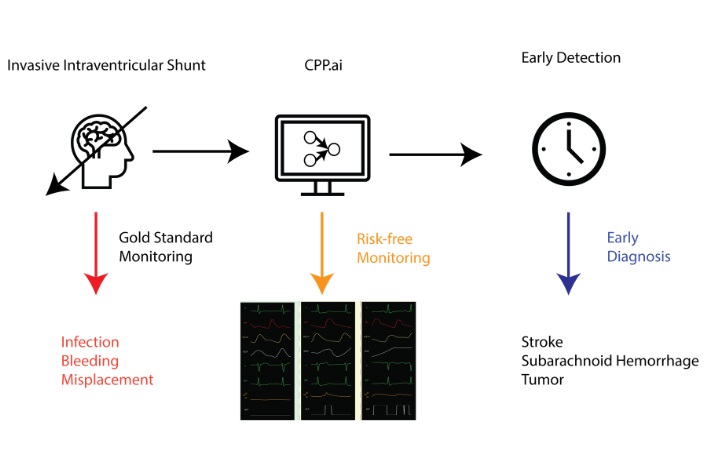AI-Driven Tool to Revolutionize Brain Pressure Monitoring in Intensive Care Patients
|
By HospiMedica International staff writers Posted on 06 Sep 2024 |

Intracranial hypertension, characterized by increased pressure within the brain, can lead to severe consequences such as strokes and hemorrhages. Traditionally, monitoring this condition requires invasive procedures that penetrate the skull. Now, researchers have introduced a noninvasive method that utilizes artificial intelligence (AI) to offer a safer and quicker alternative to the current gold standard of drilling into the skull for monitoring intracranial hypertension.
The team at the Icahn School of Medicine at Mount Sinai (New York, NY, USA) has developed an AI model that predicts intracranial pressure by analyzing noninvasive waveform data from electrocardiograms, pulse oximetry, and head ultrasounds in critical care settings. This model was trained on de-identified data from patients who previously had intracranial pressure measurements taken via invasive methods such as lumbar catheters or skull-embedded pressure sensors. This innovative real-time monitoring tool enables rapid detection of changes in brain pressure, allowing for timely interventions that could save lives.
The findings of the retrospective study published in the September 5 online issue of npj Digital Medicine that included data from two U.S. hospitals demonstrated the AI tool's efficacy in instantaneously detecting intracranial pressure. The study revealed that patients in the highest quartile of intracranial pressure measurements had significantly increased risks of severe outcomes like subdural hemorrhages and the need for craniectomies. This research is the most extensive to date concerning intracranial hypertension and the first to provide external validation for the algorithm while also correlating the biomarker with concrete clinical outcomes—a critical step for gaining FDA approval. The researchers are considering applying for breakthrough device status with the FDA, potentially accelerating the adoption of this vital technology in clinical practice.
"Our vision is to integrate this tool into ICUs as a standard part of monitoring critically ill patients. This technology represents a major leap forward, potentially transforming how we manage critically ill patients, reducing the need for risky procedures and enabling faster responses to neurological emergencies,” said senior author Girish Nadkarni, MD, PhD, Irene and Dr. Arthur M. Fishberg Professor of Medicine at Icahn Mount Sinai. “In addition, our findings suggest it could be a valuable tool not only in neurology but also in managing other severe health conditions, such as post-cardiac arrest, glaucoma, and acute liver failure."
Related Links:
Icahn Mount Sinai
Channels
Surgical Techniques
view channel
New Transcatheter Valve Found Safe and Effective for Treating Aortic Regurgitation
Aortic regurgitation is a condition in which the aortic valve does not close properly, allowing blood to flow backward into the left ventricle. This results in decreased blood flow from the heart to the... Read more
Minimally Invasive Valve Repair Reduces Hospitalizations in Severe Tricuspid Regurgitation Patients
The tricuspid valve is one of the four heart valves, responsible for regulating blood flow from the right atrium (the heart's upper-right chamber) to the right ventricle (the lower-right chamber).... Read morePatient Care
view channel
Portable Biosensor Platform to Reduce Hospital-Acquired Infections
Approximately 4 million patients in the European Union acquire healthcare-associated infections (HAIs) or nosocomial infections each year, with around 37,000 deaths directly resulting from these infections,... Read moreFirst-Of-Its-Kind Portable Germicidal Light Technology Disinfects High-Touch Clinical Surfaces in Seconds
Reducing healthcare-acquired infections (HAIs) remains a pressing issue within global healthcare systems. In the United States alone, 1.7 million patients contract HAIs annually, leading to approximately... Read more
Surgical Capacity Optimization Solution Helps Hospitals Boost OR Utilization
An innovative solution has the capability to transform surgical capacity utilization by targeting the root cause of surgical block time inefficiencies. Fujitsu Limited’s (Tokyo, Japan) Surgical Capacity... Read more
Game-Changing Innovation in Surgical Instrument Sterilization Significantly Improves OR Throughput
A groundbreaking innovation enables hospitals to significantly improve instrument processing time and throughput in operating rooms (ORs) and sterile processing departments. Turbett Surgical, Inc.... Read moreHealth IT
view channel
Printable Molecule-Selective Nanoparticles Enable Mass Production of Wearable Biosensors
The future of medicine is likely to focus on the personalization of healthcare—understanding exactly what an individual requires and delivering the appropriate combination of nutrients, metabolites, and... Read more
Smartwatches Could Detect Congestive Heart Failure
Diagnosing congestive heart failure (CHF) typically requires expensive and time-consuming imaging techniques like echocardiography, also known as cardiac ultrasound. Previously, detecting CHF by analyzing... Read morePoint of Care
view channel
Handheld, Sound-Based Diagnostic System Delivers Bedside Blood Test Results in An Hour
Patients who go to a doctor for a blood test often have to contend with a needle and syringe, followed by a long wait—sometimes hours or even days—for lab results. Scientists have been working hard to... Read moreBusiness
view channel
Expanded Collaboration to Transform OR Technology Through AI and Automation
The expansion of an existing collaboration between three leading companies aims to develop artificial intelligence (AI)-driven solutions for smart operating rooms with sophisticated monitoring and automation.... Read more


















